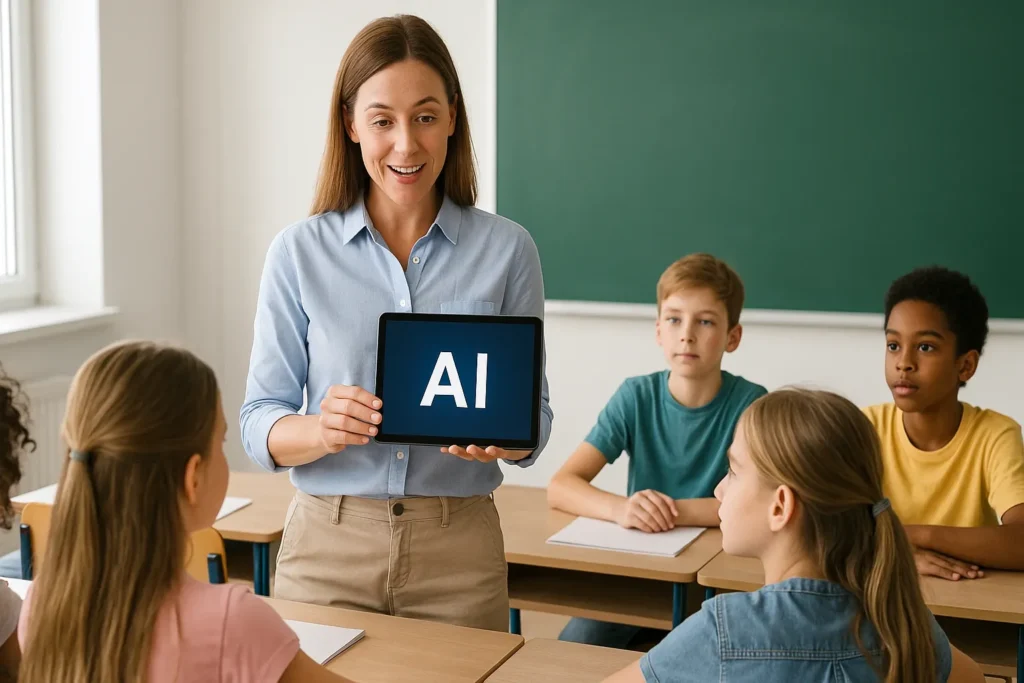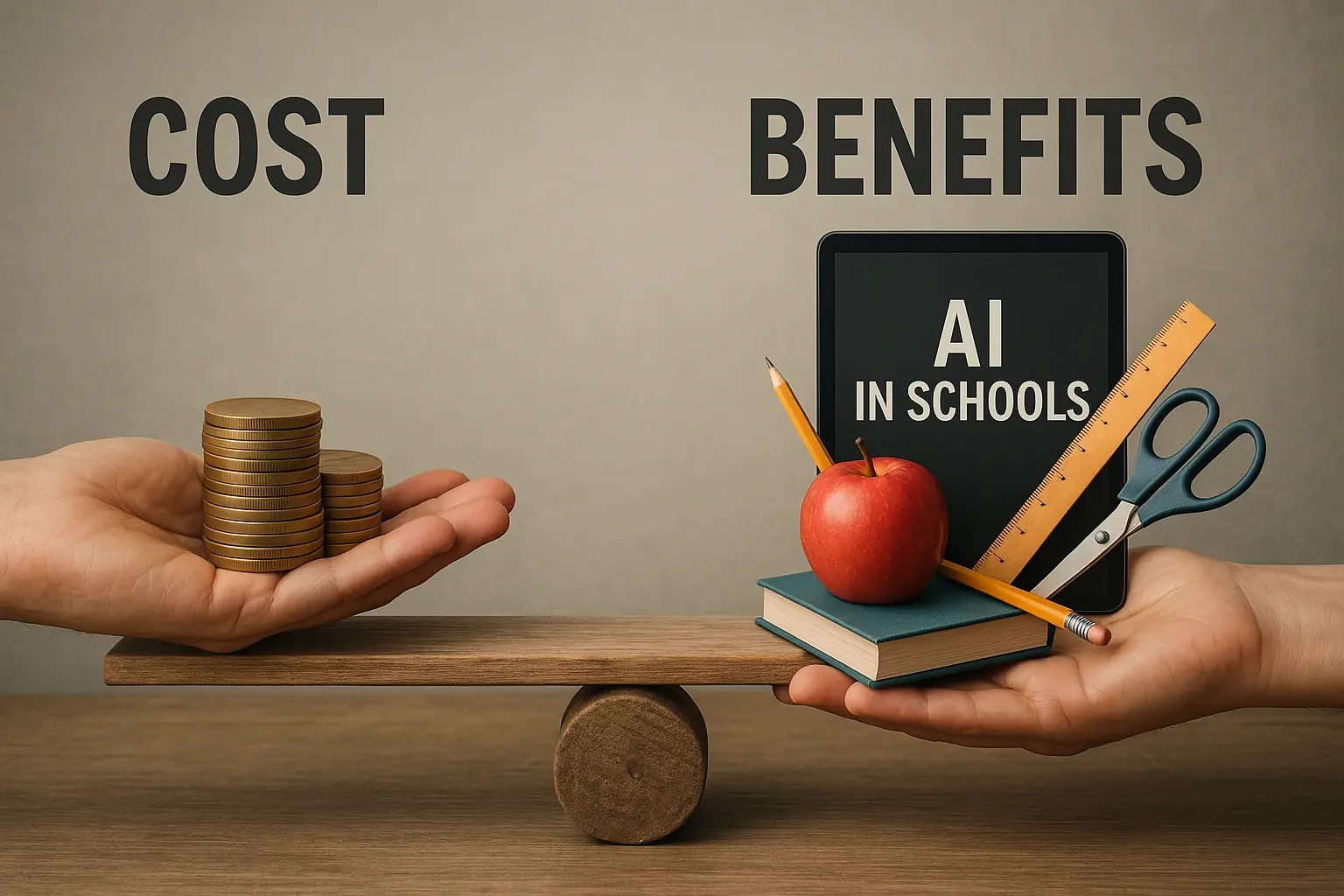Artificial Intelligence (AI) is no longer a futuristic idea—it’s here, and it’s making a real difference in schools. But what does it actually cost? And what do we gain from it? Let’s sit down and talk about the financial costs and benefits of AI in education, like two friends trying to understand if it’s worth the investment.
Understanding the Financial Costs and Benefits
The financial costs and benefits of AI in education are a hot topic. Many teachers and school administrators are curious: is AI expensive, or does it help save money in the long run?
The truth is, AI brings both costs and benefits. Some tools can be pricey, especially at the beginning. But over time, the advantages—like saving time, improving learning results, and supporting teachers—can outweigh the expenses. Let’s explore this together.
What Are the Financial Costs of AI in Schools?
Before we talk about what you can gain, let’s be honest about what AI can cost. It’s not always cheap to get started.
1. Initial Investment
Most schools will need to buy:
- Computers, tablets, or other devices.
- AI-powered platforms or apps (some are free, but many charge a fee).
- A good internet connection and IT support.
Depending on the size of the school, this can be a big investment. But it’s important to remember: this is a one-time cost in many cases.
2. Training and Support
AI can’t teach itself (yet). Teachers and staff need training. This means:
- Paying for professional development.
- Hiring specialists or consultants.
- Spending time learning how to use new tools.
It takes time and effort to feel confident with new technology.
3. Maintenance and Updates
AI platforms often require:
- Ongoing subscriptions.
- Updates and upgrades.
- Technical maintenance.
These are ongoing costs, but they’re similar to other tools schools already use.
4. Data Protection and Legal Compliance
With AI, schools collect and process a lot of data. They must follow rules like the LGPD (Lei Geral de Proteção de Dados) in Brazil and GDPR in Europe.
To stay compliant, schools might need:
- Data protection systems.
- Legal consultations.
- Cybersecurity training.
These are extra costs, but very necessary to protect students and staff.
What Are the Financial Benefits of AI in Education?
Now let’s talk about the exciting part: what schools and teachers can gain from using AI.
1. Time Is Money
Teachers spend hours on tasks like:
- Grading assignments.
- Creating lesson plans.
- Tracking student progress.
AI can help with all of that. For example, platforms like Khan Academy (https://www.khanacademy.org/) now use AI to create personalized learning paths. That means more free time for teachers and faster learning for students.
2. Personalized Learning Improves Results
AI helps students learn at their own pace. When students improve faster, schools can see:
- Better test scores.
- Lower dropout rates.
- Fewer students repeating grades.
This reduces long-term education costs and boosts the school’s reputation.
3. Reduced Need for Remedial Programs
Because AI spots learning problems early, fewer students fall behind. That means:
- Fewer extra classes.
- Less time spent catching up.
- More effective use of teacher time.
In this way, AI prevents problems instead of fixing them later.
4. Smarter Resource Management
AI can also help schools use their money better. For example:
- Monitoring energy use to cut costs.
- Predicting maintenance needs before problems grow.
- Managing schedules to reduce waste.
These “smart” decisions can save thousands every year.
Practical Examples: Real Savings in Action
Let’s look at some simple, real-world examples:
Example 1: AI for Lesson Planning
A teacher uses a free AI tool to create a week of lesson plans in minutes. Before, this took hours. That saved time can now be used to give students more one-on-one help.
Example 2: AI in Student Assessment
An AI platform grades multiple-choice and essay questions in seconds. Teachers save time and avoid burnout, while students get instant feedback. This reduces the cost of extra tutoring later on.
Example 3: AI Chatbots for Parents
Some schools use AI chatbots to answer common parent questions 24/7. This means office staff can focus on important tasks, saving both time and money.

Potential Risks and How to Handle Them
Of course, it’s not all sunshine. There are some financial risks:
- Overspending: Some schools buy expensive tools they don’t end up using.
- Wrong fit: Not all AI tools are right for every classroom.
- Tech trouble: Without proper support, systems can break down.
How to Reduce These Risks
- Start small. Try one tool at a time.
- Ask for teacher feedback before buying.
- Choose tools with free trials.
- Train staff slowly and with patience.
Why the Benefits May Outweigh the Costs
When used wisely, AI can pay for itself. Here’s why:
- It saves time.
- It improves results.
- It prevents problems.
- It makes schools more efficient.
Over time, these benefits add up—often much more than the initial investment.
The Financial Costs and Benefits of AI in Education:
| Aspect | Description |
|---|---|
| Initial Costs | Devices (computers, tablets), AI software, internet infrastructure |
| Training Costs | Professional development, training time, hiring specialists |
| Maintenance Costs | Software subscriptions, system updates, technical support |
| Legal Compliance | LGPD/GDPR alignment, cybersecurity, legal advice |
| Time Saved | Automated grading, lesson planning, data analysis |
| Improved Learning Results | Personalized learning, fewer dropouts, better test scores |
| Fewer Remedial Programs | Early detection of learning gaps, proactive support |
| Resource Management | Energy savings, predictive maintenance, optimized scheduling |
| Risks | Overspending, tool misuse, lack of support |
| Risk Mitigation | Start small, get feedback, test free tools, gradual training |
| Long-term Benefits | Efficiency, time savings, better learning outcomes, cost prevention |
| Examples | – AI-created lesson plans – Automated assessments – AI chatbots for parents |
Key Points About Financial Costs and Benefits
- AI in education has upfront costs, like equipment and training.
- Ongoing costs include subscriptions, maintenance, and compliance.
- Financial benefits include saving time, improving results, and reducing future costs.
- Real examples show how AI helps teachers and schools.
- Smart planning reduces risks and increases long-term savings.
Conclusion
AI in education is not just a trend—it’s a tool with real power. Yes, it can cost money. But when used carefully, the savings and benefits are worth it. It helps teachers work smarter, supports students better, and makes schools more efficient.
After all, investing in AI is like planting a tree. At first, it takes effort and care. But over time, it grows and gives back in many ways.
Have you tried any AI tools in your classroom or school? Share your thoughts in the comments!

